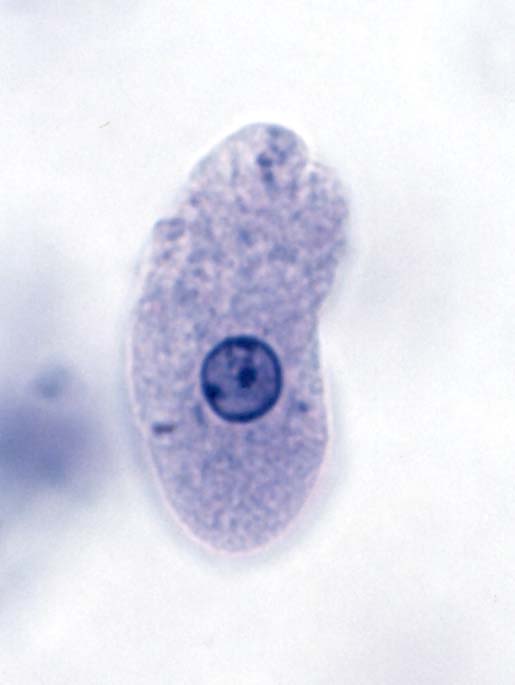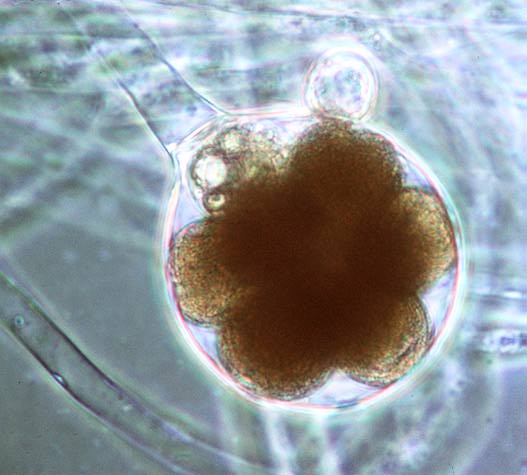Phylum Rhizopoda (Amoebas)
Entamoeba histolytica-
Are unicellular and use pseudopodia to move and to feed. The pseudopodia may bulge anywhere on the cell's surface. When an amoeba moves, it extends a pseudopodia and anchors it's tip and then more cytoplasm will stream into the pseudopodium. Their cytoskeleton conssts of microtububles and microfilaments. Some amoebas live inside a protein shell that they secrete. Amoebas are found in freshwater and marine environments are are also found in soils. They spread by contaiminated drinking water, food, or utensils.
Mycetozoa:
Dictyostelids-
-Used as examples of cellular communication and differentiation. They also provide insights into how multicellular organisms develop. Mycetozoa basically translates to fungus animals. Slime molds have structures that maximize exposure to their food sources and they also have complex life cycles that contribute to survival in changing habitats. Plasmodial slime molds are brightly yellow or orange pigment. The plasmodium engulfs food particles by phagocytosis.
Euglenozoa:
Kinetoplastics-
They are symbiotic and are pathogenic to some of their hosts. For example one of their species Trypanosoma cause African sleeping sickness, through the bite of a tsetse fly. They are characterized by an anterior pocket where the flagella emerges. They sometimes have two flagella. The cytoskeleton of kinetoplastids is primarily made up of microtubules.
Aleolata:
Dinoflagellata-
They have small membrane-bound cavities under the cell's surface. They are the most abundant in the aquatic area where phytoplankton thrive. They provide the foundation of most marine and mant freshwater organism's food. They are heterotrophic. Most are unicellular. One dangerous dinoflagellate is called Pfiesteria pisciacida is carnivorous. When the dinoflagellate blooms it's toxin stuns finish and it feeds on the prey's body fluids.
Stramenopila:
Oomycota-
Include the water molds, white rusts, and downy milkdews. Most water molds are decomposers that grow as cottony masses on dead algae and animals, but mainly in fresh water. Some are parasitic and grow on the skin and gills of fish, but they only attack when the tissue is injured or some sort. Phytophthora infesans causes late potato blight, which is what happened during the potato famine. Watermolds and their relatives have cell walls made of cellulose. These are not really related to fungi. Some of these organisms are unicellular, and some have hyphae and are conecytic.
Chlorophyta:
Chlamydomonas-
They are the simplest of the chlorophytes and are biflagellated unicells. However, they resemble the gametes and zoospores of more complex chlorophytes. In addition to unicellular chlorophytes, there are colonial species as well as many multicellular filamentous forms that contribute to the stringy masses known to be called as pond scum. Most green algae have complex life historites with both sexual and asexual reproduction. Nearly all of them reproduce sexually by the way of biflagellated gametes.
Rhodophyta:
Also known as red algae. They lack flagella and they are usually red because they have an accessory pigment known as phycoerythrin. Red algae evolved from cyanobacteria by primary endosymbiosis. Not all of rhodophytes are red because in deep water they are almost black and at moderate depths they are bright red, in shallow water they appear to be greenish in color. They are the most abundant large algae in the warm tropical oceans. The phycobilins and other accessory pigments allow some organisms to absorb light wavelengths.
Sporozoa:
The Sporozoa are parasitic protozoans that lack locomotor organs. They have no cilia, no flagella, and no pseudopods. They are usually intracellular parasites. The Sporozoa is a very large and diverse class with at least four subclasses and many thousands of species. Malaria is one of the most important sporozoan disease. Coccidiosis, which affects poultry and cattle is another. Some sporozoans live primarily in the blood cells, while others, like live in the epithelial cells lining the intestine. They have complicated life cycles involving two hosts, which includes a sexual and asexual stage.
Parabasalids-
They lack mirochondria. The best known species is Trichomonas vaginalis, they live in the vagina of human females. They infect the vaginal lining when acidity levels of the vagina are changed. Sometimes these infections can have to males too in the urethas. They have both flagellas and an undulating membrane which helps them move within the reproductive and urinary parts of human hosts.
Ciliophora-
Most live as solitary cells in fresh water. Cilia are relatively short and are associated with a submembrane system of microtubules that can coordinate the movement of the cilia. Some ciliates are completely covered by rows of cilia, while some others have fewer rows of them.They have a unique feature, they have a presense of two types of nuclei, a large macronucleus and usually several tiny micronuclei. Ciliates generally reproduce by binary fission rather than undergoing mitotic division. They also go through conjugaton.
SOURCES: campbell biology book, images from google images, wikipedia images.
http://waynesword.palomar.edu/trnov01b.htm
http://oceanlink.info/biodiversity/seaweeds/Rhodophyta.html










No comments:
Post a Comment